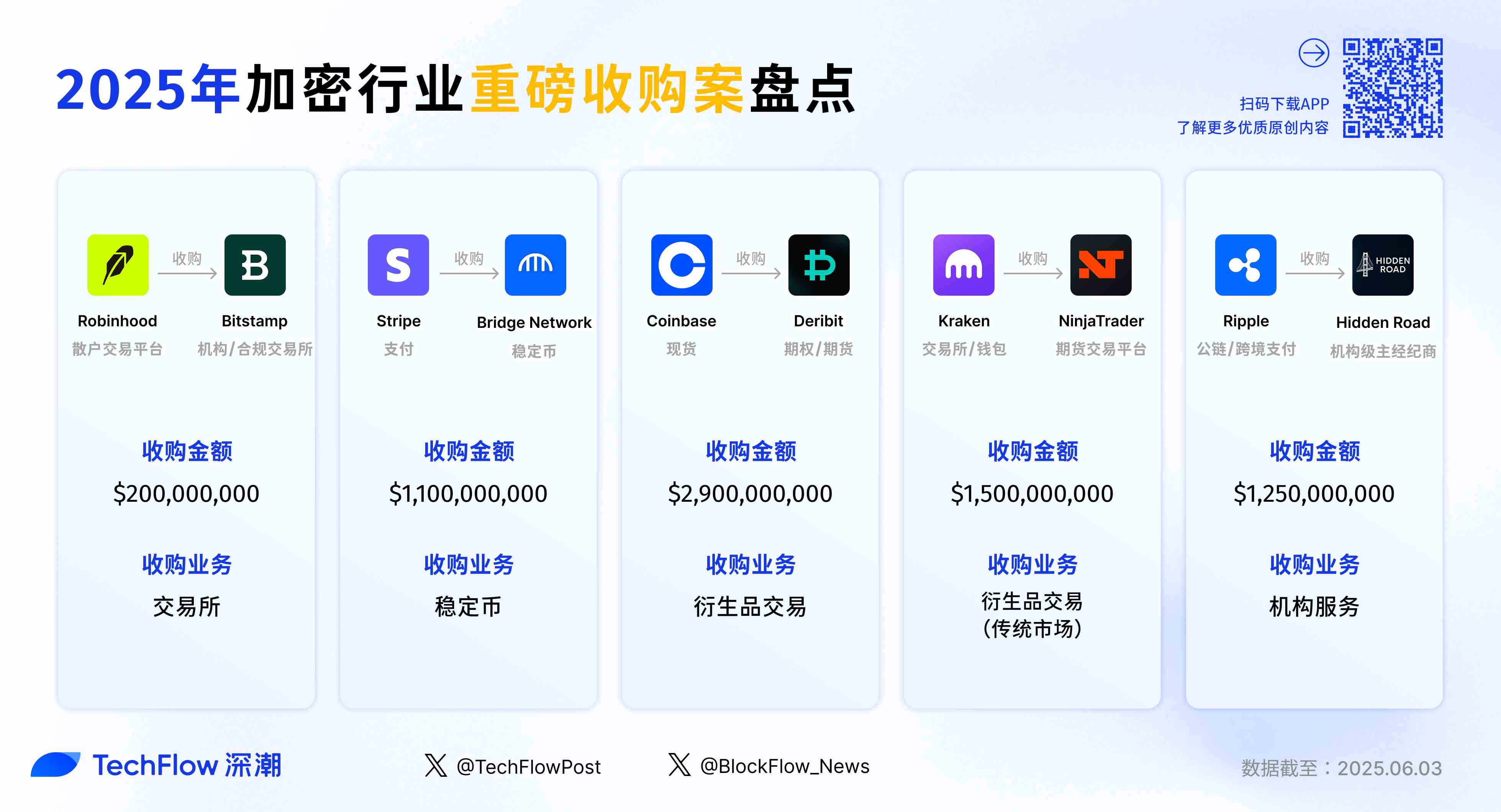The cryptocurrency merger and acquisition boom of 2025 is a two-way rush of exits and entries.
Written by: Deep Tide TechFlow

The fluctuations of the secondary market are no longer the whole story of the cryptocurrency industry.
Mergers and acquisitions are becoming the new normal in the cryptocurrency industry this year.
On June 3, Robinhood, known for its low-threshold stock and cryptocurrency trading, acquired the Luxembourg-based cryptocurrency exchange Bitstamp for $200 million in cash.
In the cryptocurrency market, buying a mature business is much more cost-effective than starting from scratch; rather than struggling from zero, it is better to exchange efficiency through mergers and acquisitions.
This strategy seems to be spreading in the cryptocurrency industry, with significant capital acquisitions frequently occurring this year, from exchanges to payment infrastructure to derivatives markets. Each participant may not have completely aligned interests, but the motivations are largely the same:
Entrants hope to band together for warmth, to grow stronger; exiters hope to sell at a good price and complete their turnaround.
Counting Robinhood, there have been five major acquisition cases in the industry this year. We summarize them as follows to see what dynamics are hidden in the capital's calculations.
1. Robinhood Acquires Bitstamp: Fast Track to Global Licensing
Acquisition Amount: $200 million
Acquisition Business: Exchange
First, it is important to know that Bitstamp holds over 50 regulatory licenses and is known for its compliance and institutional client base.
The exchange is also one of the oldest cryptocurrency exchanges, with public data showing that it currently serves 5,000 institutions and 50,000 retail users.
Robinhood needs no introduction; it is the leading retail trading platform in the U.S., previously relying mainly on stock and cryptocurrency trading revenue from American retail investors. Media analysis indicates that by acquiring Bitstamp, Robinhood gains immediate access to global markets, avoiding the lengthy licensing application and customer accumulation process, and quickly expanding into Europe, the UK, and Asia.
More importantly, with Bitstamp's existing institutional clients, Robinhood can convert institutional trading volume into a new growth engine.
Institutional trading volume injects a stable revenue stream into Robinhood, compensating for the volatility of the retail market.
The significance of this deal goes far beyond the numbers.
Robinhood not only saves the enormous costs of building a global platform but also gains institutional trust through Bitstamp's compliance reputation. In the market, this may also signal Robinhood's challenge to cryptocurrency giants like Coinbase, as a strategy balancing retail and institutional focus may reshape its brand positioning.
2. Stripe Acquires Bridge Network: Payment Giant's Crypto Layout
Acquisition Amount: $1.1 billion
Acquisition Business: Stablecoin
In early 2025, payment giant Stripe took a significant step into the cryptocurrency field by acquiring stablecoin startup Bridge Network for $1.1 billion.
Bridge Network focuses on stablecoin infrastructure, providing cross-border payment and settlement solutions for businesses, including small and medium-sized financial institutions.
As a global leader in online payments, Stripe has previously had little activity in the cryptocurrency space. This acquisition clearly indicates that the payment giant has sensed the potential opportunities in stablecoins, which align well with its existing payment business channels.
Stripe's strategy is astute: rather than spending years on research and development, it is better to directly integrate Bridge's ready-made technology to accelerate the commercialization of cryptocurrency payments.
Acquiring Bridge allows Stripe to quickly gain mature stablecoin technology and a customer network, avoiding the complex processes of developing payment blockchain and issuing stablecoins from scratch.
This deal enhances Stripe's competitiveness in the global payment market, adding a new chip in its competition with PayPal and Square. On an industry level, Bridge's stablecoin solutions may push cryptocurrency payments into mainstream retail scenarios.
However, although Stripe is large, entering the stablecoin market also requires balancing the compliance requirements of traditional financial clients with those of the cryptocurrency market; in the context of the likely passage of the GENIUS Act for stablecoins, this acquisition appears very forward-looking.
3. Coinbase Acquires Deribit: Intense Competition in the Crypto Derivatives Market
Acquisition Amount: $2.9 billion
Acquisition Business: Derivatives Trading
In May 2025, Coinbase acquired the Dubai-based cryptocurrency derivatives exchange Deribit for $2.9 billion, setting a record for the largest cryptocurrency acquisition ever.
Deribit is a leading global platform for cryptocurrency options and futures, holding half of the options trading market, primarily serving institutional and high-net-worth investors; Coinbase is the largest cryptocurrency exchange in the U.S. and has long been a dominant player in spot trading. However, its derivatives business is relatively weak, and acquiring Deribit allows Coinbase to inherit its mature trading system and institutional client base directly, saving the lengthy cycle of building a derivatives platform.
Coinbase not only fills a business gap but may also leap to become a leader in the global derivatives market, intensifying competition with Binance in contract trading.
At the same time, Deribit's compliance framework may promote the standardization of the cryptocurrency derivatives market, attracting more institutions to enter. However, $2.9 billion is not a small number; the high acquisition cost and integration difficulty will test Coinbase's operational capabilities, and how to recoup this investment will require further observation.
4. Kraken Acquires NinjaTrader: Transition from Crypto to Multi-Asset
Acquisition Amount: $1.5 billion
Acquisition Business: Derivatives Trading (Traditional Market)
In March 2025, Kraken acquired the futures trading platform NinjaTrader for $1.5 billion, marking its transition to multi-asset trading.
NinjaTrader is a leading platform for retail futures trading, boasting a large active trader community and covering traditional financial assets such as stocks, futures, and forex.
As an established cryptocurrency exchange, Kraken has faced user growth bottlenecks in recent years.
Acquiring NinjaTrader allows Kraken to quickly gain mature futures trading technology and a user base, avoiding the resource investment required to build a multi-asset platform from scratch.
Kraken's ambition is evident: through mergers and acquisitions, it aims to rapidly transition from a single cryptocurrency exchange to a comprehensive trading platform, attracting traditional financial users into the cryptocurrency market. This deal may reshape Kraken's brand image and enhance its competitiveness in the North American market.
On an industry level, the further acceleration of the integration of cryptocurrency and traditional finance is an obvious trend; Kraken's acquisition move also provides retail investors outside the cryptocurrency circle a new option, as traders still using NinjaTrader can also venture into cryptocurrency assets later on;
Moreover, the integration of cryptocurrency and stocks on one platform offers users in the cryptocurrency space more diverse choices.
5. Ripple Acquires Hidden Road: The New King of Institutional Services in Crypto
Acquisition Amount: $1.25 billion
Acquisition Business: Institutional Services
In April 2025, Ripple acquired multi-asset major broker Hidden Road for $1.25 billion, becoming a pioneer in institutional services in the cryptocurrency industry.
Hidden Road provides brokerage services for stocks, cryptocurrencies, and forex to institutions, including hedge funds and asset management companies. Ripple is known for XRP and cross-border payments and has recently launched the stablecoin RLUSD.
Acquiring Hidden Road allows Ripple to gain direct access to a global brokerage network and institutional clients, enhancing the institutional application scenarios for RLUSD and making Ripple the only cryptocurrency company with a global multi-asset brokerage, finding its foothold in a market dominated by USDT and USDC.
In terms of market impact, Hidden Road's compliance advantages may attract more institutions to enter the cryptocurrency space, promoting industry standardization. However, Ripple's XRP lawsuit has not yet fully concluded, and regulatory risks may affect the integration process.
Between Mergers and Acquisitions, the Game of Entry and Exit
Looking back at these significant acquisition cases that occurred in the first half of this year, it seems that this wave is not just a capital frenzy but more like a game between entry and exit.

On one side are cryptocurrency companies seeking exits, eager to lock in profits through IPOs, acquisitions, or mergers; on the other side are traditional companies and "old money" capital, eager to cut into this high-growth market through** mergers and acquisitions.**
Many cryptocurrency companies actually have a demand to exit, and the methods of exit are mostly through IPOs or being acquired.
An IPO is a prominent path; for example, stablecoin issuer Circle plans to go public in 2025 with a valuation of up to $9 billion. Circle rejected Ripple's acquisition offer of $5 billion, choosing an IPO to realize greater value, demonstrating the confidence of mature cryptocurrency companies in the capital market.
However, an IPO is not the only way out.
Robinhood's acquisition of Bitstamp for $200 million is actually a good example, showing that cryptocurrency companies can quickly realize value by selling to strategic buyers, especially for platforms with complete licenses and a solid customer base.
The lengthy cycle and high costs of building a business have deterred many small and medium-sized cryptocurrency companies or outside companies, making selling to larger players a more realistic choice.
This wave of exits also reflects signs of industry maturity: profit pressures and regulatory requirements are forcing companies to reassess their long-term strategies.
At the same time, traditional companies and established capital are flocking in, viewing the cryptocurrency market as a new growth engine.
Payment giant Stripe's entry is similar; private equity firms and traditional financial giants ("old money") are also rushing in through mergers and acquisitions.
A report from Financial IT shows that in the first half of 2025, there were 88 cryptocurrency merger and acquisition transactions totaling $8.2 billion, nearly three times the total transaction value of 2024.
The participation of traditional finance is significantly increasing.
These players are not only interested in technology but also in ready-made customer networks, compliance frameworks, and market shares. Acquiring mature companies allows them to establish a foothold in the shortest time, especially in the context of tightening regulations, where licenses and compliance become scarce resources.
The entry of traditional capital is blurring the lines between cryptocurrency and traditional finance, accelerating the industry's legitimization.
Overall, I believe that the cryptocurrency merger and acquisition boom of 2025 is a two-way rush of exits and entries.
This inevitably brings to mind a saying:
The cryptocurrency circle is just that big; when some come in, some have to leave.
免责声明:本文章仅代表作者个人观点,不代表本平台的立场和观点。本文章仅供信息分享,不构成对任何人的任何投资建议。用户与作者之间的任何争议,与本平台无关。如网页中刊载的文章或图片涉及侵权,请提供相关的权利证明和身份证明发送邮件到support@aicoin.com,本平台相关工作人员将会进行核查。




